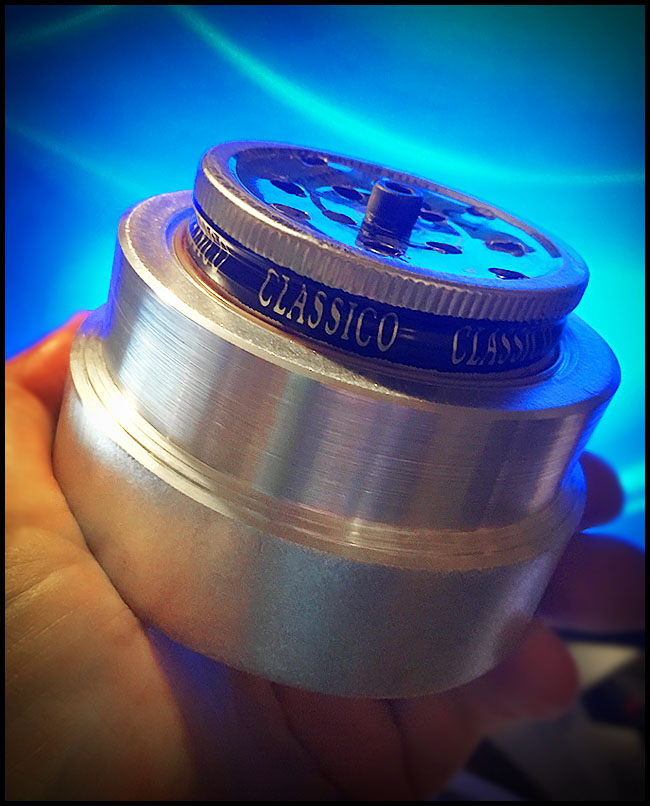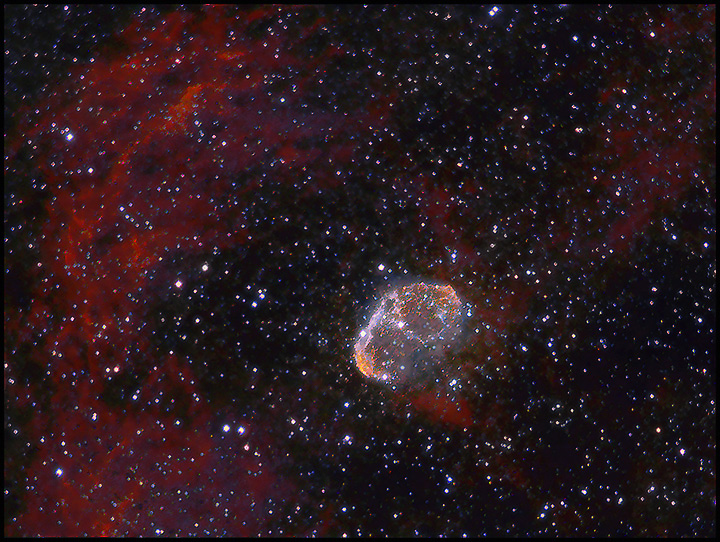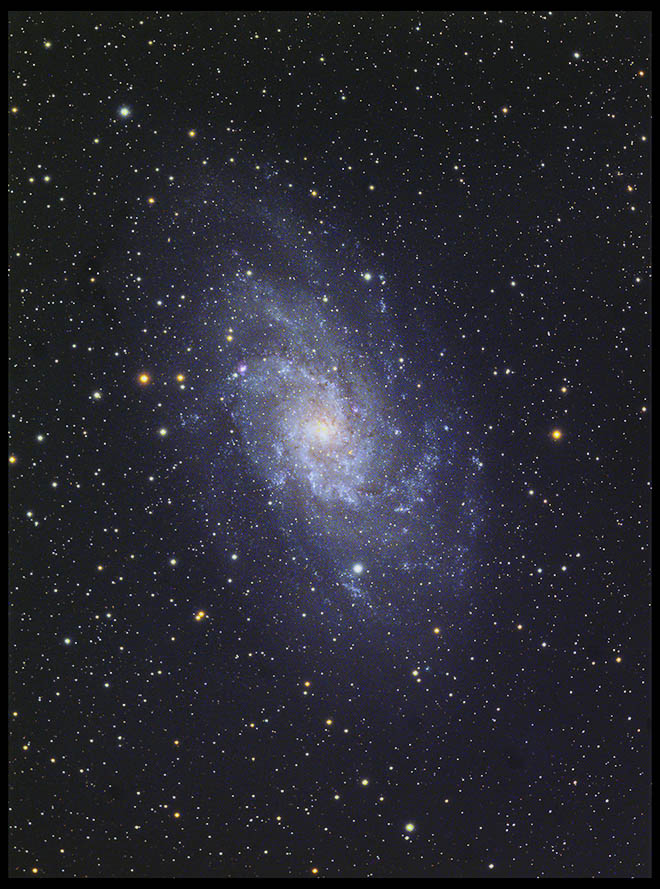Special Sauce
11/03/2016. The focusers on the bargain Ritchey-Chretiens from Astro-Tech / Astronomics / GSO / Teleskop-Services are liabilties. They work, mostly, but they need help lifting a load as heavy as a CCD and filterwheel. Sometimes mine works fine, sometimes not. When seeking best focus it will usually move repeatably in one direction but not the other. Tedious. I tend to accept less than perfect adjustment in favor of "good enough." There's probably a fair amount of optical quality left on the table.
 Psst, there are focusers that do not suffer from this feature. Instead, they suffer from price. A full-on 3-inch Feathertouch focuser from Starlight Instruments costs almost half what I paid for the entire 10-inch R-C (it's a steel tube model, a demonstrator, caught with a nice discount). The TMB92SS is equipped with that very same 3-inch focuser (except the drawtube is an inch longer than the 1.5-inch drawtube on the model sold as an upgrade for the R-C). Wayne Shroeder of Starlight Instruments verified that that difference should not present a problem. All I needed to use it on the R-C was an off-the-shelf adapter ("We have one ready to ship out," said Wayne). It is, of course, a sublime piece of machining.
Psst, there are focusers that do not suffer from this feature. Instead, they suffer from price. A full-on 3-inch Feathertouch focuser from Starlight Instruments costs almost half what I paid for the entire 10-inch R-C (it's a steel tube model, a demonstrator, caught with a nice discount). The TMB92SS is equipped with that very same 3-inch focuser (except the drawtube is an inch longer than the 1.5-inch drawtube on the model sold as an upgrade for the R-C). Wayne Shroeder of Starlight Instruments verified that that difference should not present a problem. All I needed to use it on the R-C was an off-the-shelf adapter ("We have one ready to ship out," said Wayne). It is, of course, a sublime piece of machining.
...to the ridiculous. I turned an endcap to seal the tube of whichever telescope is not blessed with the focuser at any given time. I left it hefty to approximate the balance point of the missing focuser, and I made a cage for desiccant packs on the plug's inside surface to help keep the optics dry. I copied that idea from a commercial product (a 2-inch desiccating plug from Farpoint) that came with the TMB92SS courtesy of its previous owner.
OK, look, I never said this was a work of art.
I carved a ditch for desiccant packets on the inside surface of the 3-inch plug. The lid from a Classico marinara sauce jar serves as the cage. I drilled a dozen 1/4-inch holes in the lid to let moist air in and dry air out and bolted it to the plug.
Now, about that orientation scale... I need to replicate the one I put on the stock R-C focuser. Iterations toward perfection can wait, but I do need to be able to anticipate how maps generated by Guide will translate to imaging and guiding fields on the chips.
11/04/2016. I was going to change back to the 6D after taking a few frames for orientation and to verify that the camera is frost-free, but I decided to do a narrowband image while all was in readiness. Therefore, this: 4 H-a and 4 O-III frames, 900s each, at -25C (yes, I have a master dark for that --it's old but it's handy). This image would have worked out even better had I remembered to refine the focus before pressing "start." There's been some rough and ready sharpening to get this far:

NGC 6888
TMB92SS & ST2000XM CCD
Red: 3x900s H-a, Blue: 4x900s O-III (1h 45m)
Average used for the green channel
After the field got down toward the treetops, I refocused on Deneb then turned to M33 and had a terrible time locating guide stars. I'd rotated the camera 180 degrees, where Guide indicated there should be some. Maybe an obscure or not-so-obscure parm needs to be adjusted. I took out the 50mm guide 'scope with the Meade DSI and used that with PHD Guide. And even that gave me fits. Finally, I switched off the "use dark library" option and all was well. I'll rebuild the library by and by. It now occurs to me that in taking narrowband data with the TMB, the seperate guide scope may be preferable to the SBIG's internal guide chip -- there will not always be adequate guidestars behind the TMB's 92mm aperture (compare to the the AT10RC's 250mm).

M33
TMB92SS @ F4.4
ST2000XM, LRGB
24x300s L, 2x300s RGB (2h 30m)
Click it!
I'd intended to take Pleiades images late, but I am not in the mood for another fight. I thought, let's just let the outfit do M33 all night tonight, a healthy mix of mostly luminance frames and a few RGB's tossed in for good measure. The chip is holding -30C easily (it's 44F out there), and I'm not seeing any frost. I put the AstroZap flexible dew shield from the 5-inch A-P on the TMB --it needs to be taken in a bit in order not to keep falling down. That is a project for daylight. Is helps "some" as it is. But we were up very late, and at 3:15, while standing in the shower, I realized that I would only get another hour of M33, but I could easily take 3 or 4 hours of darks and they would contribute more to good pictures tonight and for the rest of the winter than a little more data from M33 could.
So I went out in my robe, parked the scope, covered the lens and reprogrammed the autosave sequence to give me a lot of 300s darks and some 900s darks. A really sparkling sky seemed wasted, but that's just the way it has to go sometimes.
My deep-sky photos are made with a variety of sensors and optics. Deepest images usually come from a SBIG ST2000XM CCD behind a 10-inch Astro-Tech Ritchey-Chretien carried on an Astro-Physics Mach1GTO. The CCD is equipped with a CFW-10 loaded with Baader wide- and narrow-band filters. Camera control and guiding are handled by Maxim DL 5.12. A Canon 6D and a modded 50D find themselves mounted behind an Orion 10" F4 Newtonian or a 92mm Thomas Back refractor or a tiny but mighty AT65EDQ refractor, sometimes with Backyard EOS in control and PHD Guide keeping things on target. Really widefield photos are often made using the 6D and various camera lenses and an iOptron Skytracker mount. PixInsight does most of the heavy lifting in post-processing — alignment, stacking, gradient removal, noise-reduction, transfer function modification, color calibration, and deconvolution. Photoshop along with Focus Magic and a handful of other plugins get their licks in, too, especially when polishing for the web.
:: top ::